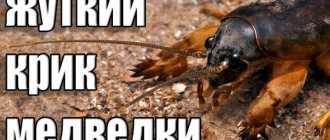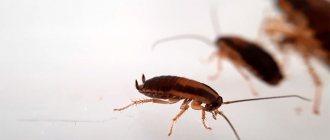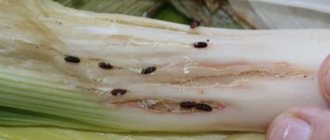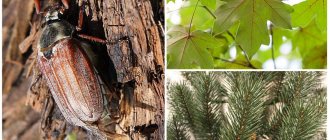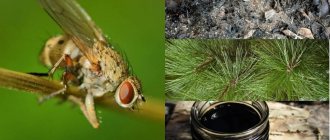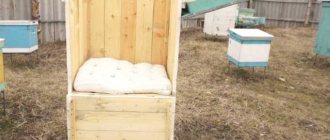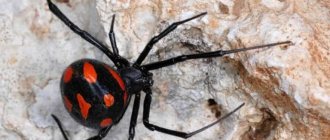The onion fly is a type of garden pest that damages plantings of onions, garlic and bulbous flowers. If onions are attacked by such a pest, signs of this phenomenon appear in a short time. External symptoms include slow growth of the onion plant, yellowing of feathers, wilting and drying. In addition, the planting produces a smell that is different from onion. The dug up bulbs of infected plantings are distinguished by the presence of a coating similar to rot.
Subsequent softening of the fruits makes them unsuitable for consumption or storage. However, there are a large number of chemicals and folk remedies that can help not only against onion diseases, but also in solving the problem of onion fly and how to deal with it.
Life cycle of the onion rattle
As you can see in the photo of the onion leaf beetle, it is a bright, red-orange beetle with 10 rows of black dots on the elytra. Its abdomen is black, and its legs are red with black spots on the joints. The eleven-segmented antennae of this insect are black. The pest has a thick, oval-shaped body, reaching a length of 6-9 mm, with a large head and bulging eyes located on the side protrusions.
In May-July, female leaf beetles lay eggs. Each insect produces a total of up to 250 eggs, placing them in small groups of 6-20 on the underside of the leaf blade of the bulbous plant. They are poorly attached to the leaf, causing them to fall off at the slightest touch. The eggs of the onion rattle are about 1 mm in length, elongated oval in shape, and have a translucent thin shell. Initially they are colored yellow or orange, but over time they acquire a red tint, and before the appearance of the larvae they become brown.
After 6-10 days, the onion leaf beetle larva is born from the egg. It has a soft, thick, up to 10 mm long body with six legs and a developed head, on which powerful gnawing jaws are located. The larva has a dirty yellow body color, and its chest shield, head and paws are black. The paws and chest shield are almost always covered with brownish mucus. The newly emerged larvae eat the side leaves of the plant and its top. Having matured, they gnaw huge holes in the leaves and penetrate into the middle of the tubular leaf, destroying the plant from the inside.
After 15-21 days of life, the mature larvae of the onion leaf beetle fall to the ground. In the soil, at a depth of 15-20 cm, they pupate, turning into soft white pupae. This stage lasts 13-21 days. In June and July, a new generation of beetles emerge from these pupae. As a rule, in the middle zone this pest gives one generation, and in the southern zone - two.
Miners
Miners are harmful larvae of moths and other insects living inside the trunk or leaf of a plant. In case of mass damage, they lead to the death of various crops. Resistant to insecticides.
Miners are harmful larvae of moths and other insects living inside the trunk or leaf of a plant. In case of mass damage, they lead to the death of various crops. Resistant to insecticides.
March 14, 2014 / LePlants.ru editors / Rating:
Description:
“There are mines in the leaves!” For some, this phrase will cause a bewildered smile, and only an experienced plant grower will be seriously alarmed. Miners are the larvae of moths, some types of flies, beetles, wasps, and many varieties of sawflies that lay eggs in plant tissue. After a week or two, a larva emerges from the egg.
It does not crawl out, continues to live and, what is most dangerous, feeds intensively inside the leaf or trunk of the plant. The origin of the name of these pests is not accidental and even has something to do with military operations. In the old days, the word “mine” meant “undermining, underground passage.” Accordingly, the “miner” is the one who built this tunnel. By analogy, pests that lead a hidden lifestyle, gnawing “holes” in the tissues of foliage, stems and trunks of ornamental, vegetable and garden crops received this name.
Single lesions cause almost no harm, although there is a danger of fungal or viral infection. However, you should beware of mass infection with miners. It can lead to the death of even a large tree or shrub, not to mention delicate indoor plants.
Some species of miners are oligophagous, that is, they prefer to feed on one type of plant. Others are polyphagous, they are not so picky in their choice and value variety. Of the flowering plants, the most susceptible to leaf miner attacks are zinnia, chrysanthemum, rose, rhododendron and violet.
Miner larvae rarely exceed 2–3 mm in length and are brownish in color. It is almost impossible to notice them, except by the traces left behind. Over the course of several days, they eat away leaf tissue until the pupation process begins.
IN THE PHOTO: Miner trace on a plant leaf
A butterfly, fly or beetle sat down on a leaf, rested, took off, leaving behind a whitish or yellowish bubble - egg laying has taken place. If the process does not go unnoticed, it is better to remove the sheet immediately.
Unfortunately, in most cases, leafminer damage becomes noticeable too late. This is indicated by a eaten away ribbon-like path or spot on which the leaf tissue has already turned yellow or acquired a whitish or brown tint.
There are types of miners that leave behind a different mark: tissue grows at the site of the mine, this part of the leaf becomes slightly convex. It is recommended to pay attention to the swarming of small insects near the plant - this could be a massive outbreak of leaf miners of one type or another.
Signs:
A butterfly, fly or beetle sat down on a leaf, rested, took off, leaving behind a whitish or yellowish bubble - egg laying has taken place. If the process does not go unnoticed, it is better to remove the sheet immediately. Unfortunately, in most cases, leafminer damage becomes noticeable too late.
This is indicated by a eaten away ribbon-like path or spot on which the leaf tissue has already turned yellow or acquired a whitish or brown tint.
There are types of miners that leave behind a different mark: tissue grows at the site of the mine, this part of the leaf becomes slightly convex. It is recommended to pay attention to the swarming of small insects near the plant - this could be a massive outbreak of leaf miners of one type or another.
Control measures:
Miner insects are numerous, mobile and inconspicuous, so effective prevention measures are practically non-existent. The risk of infection can be reduced by protecting open doors and windows with mosquito nets during the summer and regularly inspecting plants. In the case of a single lesion, when one or two miners are found on a large plant, you should simply remove the leaves with the larvae hiding in them.
If the number of miners is one or two per leaf, extreme measures should be taken and insecticides should be used. The most effective are pyrethrum-based sprays.
They are very toxic and therefore require all precautions when used. Spraying is carried out 5–6 times with an interval of three to five days. It is imperative to change the drugs used: miners very quickly adapt to the effects of pesticides and stop reacting to them.
Among insecticides, Actellik and Dimilin are quite effective. Each of them should be used strictly according to the manufacturer’s instructions and only when the plants are severely infected. In case of mass flight of insect miners, adhesive tapes or yellow boards will help.
Subscribe to new articles in the Garden section and receive updates by email. Expert articles on gardening care are understandable and accessible to everyone!
Common pests of onion plantings
The list of insect pests that damage onion plantings includes:
- Onion fly that damages the plant during the growth period. The planting that was sown by seed to germinate the sets is most susceptible to invasion by these pests. Larvae from dense stems begin to crawl from infected plantings to healthy ones. The risk of onion flies is significantly reduced if, when growing bulbs from sets, you do not have to deal with thinning. Also, the onion fly begins to fly especially actively and attacks onions that are sick with stem nematode. The main sign of onion fly damage is considered to be wilting of the planting in the first leaf phase. The color of an adult individual is distinguished by a light gray tint with a body length of 8 millimeters. The wing color is yellowish;
Onion fly
- The onion moth, which is a small butterfly with brown wings. The color of the caterpillar is yellowish-green. The wintering places for insects are onion residues, greenhouses and sheds. The location for the ovipositor can be an arrow, a bulb, or the back of a feather. The harm from onion moths consists of its larvae eating the feather pulp;
- The root beetle is a fly that damages the onion plant in the second half of the growing season. Symptoms of the appearance of the root beetle are slow growth, yellowing of feathers with their subsequent wilting. The onion fruit acquires a soft consistency with a repulsive specific odor. A group of these insects can turn one bulb into a putrid black mixture. The root beetle is a medium-sized fly with a bronze-green body color and two light gray stripes on its back;
- Tobacco thrips is an insect that harms onion feathers and the fruit itself. The scales damaged by tobacco thrips become rough until they completely dry out. Severely damaged feathers turn white, curl and dry out. In addition to stopping the development of the plant, its seeds cannot be used for planting. The color of the insect is yellow, with a body length of 1.5 mm;
- Onion rattle, damaging the planting in individual outbreaks. The 6mm beetles are distinguished by their red color. Around the larva you can find a mass of brown color. The harm caused by this pest is the breaking of onion feathers;
Onion rattle - Weevil, which is a black 3-mm beetle with a characteristic elongation at the end of the head. The object of damage by the weevil is a diseased sprouted onion that has not been removed from the ridge. The harm caused by the weevil consists of piercing the onion feather with the help of an extension on the head and eating its pulp. On diseased leaves, you can find white round spots that resemble needle pricks, which lead to their drying out and the death of the plant. When growing onions by seed, the risk of weevil outbreaks increases significantly;
- Onion nematode is an insect that looks like a small thread-like worm, 1.5 mm in length. The place that serves as protection for stem nematode larvae from winter cold can be the ground, onion fruit and seed material. The stem nematode can get into onions both through feathers and through the vegetable. Symptoms of the appearance of onion nematodes in plantings are expressed in the flaccid appearance of the plant, as well as in the presence of thin areas in the affected areas. Both rotting and drying of onions can occur, depending on air humidity. The time of the most active activity of the stem nematode is the second half of the summer season.
- Mites most often attack onion fruits placed in a house or barn for storage. The habitat of mites is the areas between the scales, which is why the onion slowly begins to rot. Signs of mites are the appearance of yellow-green pigmentation on the inner scales, which is best visible during the storage of dried crops. During the growing season, yellowing and curling of feathers, as well as slower growth, appear;
- An armyworm gnawing on both onion fruits and feathers. The period of its activity occurs at night. The cutworm is a 5 cm butterfly. The consequences of damage by cutworms are that the onions acquire a repulsive odor and subsequent rotting;
- Shallot aphid, characterized by a brown body color. When damaged by this pest, feathers wither and become bent, as well as slow growth of the entire plant. The habitat of shallot aphids on onions is the feather part.
Onion fly
The onion fly (Delia antiqua) is ubiquitous. It affects crops of onion sets, onion, allium, and garlic. The onion fly is light gray in color, body length is 6–7 mm, it is slightly larger than a housefly.
The flight of the fly begins at the end of May. During the flight, flies lay white eggs in onion and garlic beds near growing bulbs, directly on the outer surface of the bulb if it is planted shallow in the ground, or in the neck of the bulb. After about a week, larvae hatch from the laid eggs. Within 3–4 weeks, the larvae eat away inside the bulb, mainly in the lower, root part. In July, the flight of the second generation of flies begins, the larvae of which damage onions and garlic that were planted late.
Plants affected by the fly are noticeable by prematurely yellowing leaves. The larvae penetrate the bulb, which then rots and the leaves turn yellow.
Measures to combat onion fly
To combat the onion fly, you need to sow onions and garlic as early as possible, because late plantings of onions and garlic are more damaged by the fly. When planting, bury onion sets or turnips in the ground 2–3 cm. In this case, the bulbs will form in the top layer of soil, which creates unfavorable conditions for egg laying and further development of onion fly larvae. When planting onions and garlic, you can add Medvetox-U, which will serve as protection not only from the onion fly, but also from mole crickets and cutworms. Combined crops of onions and carrots can be used against onion flies.
During the period of onion fly larvae hatching, once a week you can water the onions and garlic with a solution of table salt (200 g per 10 liters of water) or every 10 days with a solution of ammonia (3 tablespoons per 10 liters of water), but the solution should not get into on onion or garlic leaves. The first watering with saline solution or water with ammonia should be carried out when the onion reaches a height of 3–5 cm. Once a week, it is recommended to periodically inspect the onion and garlic crops, remove and destroy damaged leaves and bulbs.
You can use insecticides against onion flies - Karate, Ratibor, Inta-vir and their analogues. Treatments are stopped 20 days before harvesting.
Carefully remove plant debris after harvesting and destroy. If you intend to use them in a compost heap, then first treat them with insecticides.
In the fall, the site is dug up deeply. To repel onion flies during flight, sprinkle the soil along the rows with tobacco dust in pure form or half and half with lime or ash (1-2 kg of mixture per 10 m2).
How repellent devices can help
Windmills, which are something like an ordinary tin turntable, but much larger in size, have proven themselves well. They must have a base that can be buried deep into the ground. The created resonance will cause concern among the inhabitants of underground burrows. Only rats that easily adapt to changing conditions and get used to any noise can cope with such a psychological attack.
How to make a windmill with your own hands
You can make such a device yourself. We will need a small square board or plastic cube. A metal tube from two to one and a half meters long is attached to it from below. It should be dug into the ground to a depth of one to one and a half meters. Plastic bottles with plates threaded through them are attached to the edges with screws. The plates are needed to make the bottles spin in the wind and create a characteristic sound that spreads deep through the base.
Appearance of ratchets
The eggs of rattlers are translucent, light, oval in shape. The shell of the eggs is thin.
Rattlers (Criocerinae).
The heads of ratchet larvae are covered with a durable chitinous layer. On the head there is a gnawing type mouthparts. The body of the larva is soft and dirty-white. She has 6 legs. The head is black, so it stands out against the overall light tone. The chest plate and limbs are covered with excrement and mucus.
Features of the development of ratchets
The duration of egg development depends on external conditions - humidity and temperature.
The subfamily of rattles has about 2000 species.
The larva develops in about 20 days. It feeds on leaves, seeds, flowers and buds. Larvae develop at the site of oviposition. And they turn into a pupa in the soil or on fallen leaves. Some species pupate directly on plants, while others make galls in cereal crops.
The adult emerges from the pupa closer to autumn and remains to overwinter in the soil.
Preventive measures
In order to prevent the appearance of the parasite on plantings, it is necessary to use agrotechnical methods. First of all, it is necessary to regularly water the seedlings and carry out weeding, since the insect first feeds on weeds, and only then switches to onion plantings.
After harvesting, be sure to remove the grass from the beds. Better to burn it. Then carefully dig up all the soil. Since the pest's pupae overwinter in the soil, this method will prevent the emergence of adults in the next season.
You also need to loosen the soil between the beds from June to July, as this is the period of main activity of onion borers.
To maintain moisture levels, you can use soil mulching.
Onion moth
Onion moth (Acrolepia assectella Zeller) damages onions, leeks, and garlic in warm and dry summer weather. Light spots of irregular shape appear on onion leaves - mines. Damaged onion leaves begin to turn yellow and dry out from the tops.
12 best fabric softeners according to user reviews and expert opinions
In May, butterflies begin their flight. The onion moth is a small butterfly, its body length reaches 6–8 mm, and its wingspan is 12–14 mm; it flies mainly at night.
Female onion moths lay single yellowish eggs, about 0.5 mm in size, on the underside, at the base of onion leaves or on the flower stalk of garlic. The hatched caterpillars gnaw into the leaves, live and feed inside them, and gnaw the flower shoots of onions and garlic. The main damage to onion moth caterpillars of the first generation is caused to onions in June.
They are yellow-green in color with brown warts on the back, up to 1 cm long. At the end of July - beginning of August, the flight of the second generation of onion moth begins. Hatched onion moth larvae harm late onion plantings. At the end of September - beginning of October, butterflies of the second generation appear and overwinter on the ground, in the bed where the onions grew, in fallen leaves, and on non-composted plant debris.
Measures to combat onion moth
To combat onion moths, it is recommended to remove all plant debris from the garden bed, dig up the soil in the fall, and observe crop rotation, in which the planting of onions and garlic is returned to the same place no earlier than after 3-4 years. Next year, plant onions and garlic as far as possible from the places where they were grown this year. It is also not recommended to plant onions next to garlic.
During the period of flight and the appearance of the first signs of damage on onions, it is recommended to treat onion crops with insecticides, for example, Iskra, Inta-Vir, karbofos and their analogues according to the attached instructions.
Description of the insect
Rattlers belong to the suborder Polyphaga. Information about these insects is extremely scarce and, at best, is represented by the name of the food plant. Monocot plants most often serve as the food base for beetles and larvae. Sometimes dicotyledonous plants are used for food.
Rattlers are characterized by leading an open lifestyle. They primarily damage leaves and stems. They can use asparagus fruits for nutrition.
Larva
The light and translucent egg of this pest is oval in shape. It is distinguished by a thin shell that does not have a sharp sculpture. The duration of embryonic development depends on external conditions and indicators of temperature and humidity.
The rattle larva is characterized by a well-developed head with a durable chitinous layer, on which gnawing mouthparts stand out. The soft body is off-white in color and has six legs. Against the background of light covers, the black head is clearly visible. The covering of the chest shield and legs consists of mucus and excrement. The duration of larval development does not exceed 20 days. Leaves, buds, flowers and seeds are used for nutrition. The space for development is the oviposition site.
Pupa formation occurs in the soil. Pupation can also occur on the soil surface, as well as among fallen leaves. Oulema gallaeciana forms a pupa directly on plants.
A little-studied species, Ortholema samalkotensis, can form galls on the leaves of cereal crops. The white puparia is loose and soft. The adult emerges from the pupa closer to the autumn period and remains in the soil for the winter.
Feeding and new soil for sick asparagus
But sometimes the cause of the disease is not so obvious. After all, even experienced gardeners do not always think that asparagus needs feeding, and they completely forget about timely transplantation of the crop - the plant is so hardy and unpretentious.
The root system of asparagus is voluminous and quickly growing, so in early spring the plants are transplanted into fresh soil. At the same time, for young specimens it is better to carry out the procedure annually, and adult asparagus are transferred to a new container after 2–3 years. If the grower has forgotten about replanting the pet, the roots and tubers come to the surface, and the plant begins to experience an acute deficiency of nutrients and moisture. Asparagus will not turn yellow and crumble soon, but this will not have the best effect on the appearance and condition of the flower.
Replanting is also useful in that it helps to identify diseases and pests on the roots of asparagus that have not yet made themselves felt or have already caused the stems to dry out.
Fertilizing is carried out in spring and summer, and here you need to take into account that asparagus loves organic matter and nitrogen-containing mixtures, but an excess of this element can play a bad joke. A growth stimulator for greenery in a plant located in the shade causes shoots to stretch, and sometimes asparagus turns yellow due to excess fertilizer. Therefore, it is useful for your pet to choose a fertilizer with a harmonious content of all nutritional components and microelements.
Adult
The most common and studied species is the onion rattle or Lilioceris merdigera.
This onion leaf beetle is a beetle whose thick body is up to 7.5 mm long. The head is large in size with a raised forehead. The frontal part is limited by narrow deep grooves and divided by a longitudinal smooth groove.
Characteristic are very convex eyes located on the sides of the head capsule. A prominent constriction located behind the eyes floats onto the crown. The rounded pronotum can be longitudinal or square and has a notch in the middle segment. The pygidium has a stridulatory apparatus.
A distinctive feature of the spaced claws is their strong curvature. The claws are spaced and strongly curved. The reddish color gives way to black, which covers the abdomen, legs and knees. The antennae can be entirely black, black with a red ring, or entirely red. The elytra are wider than the pronotum.
Ways to combat onion leaf beetle
It should be noted that all of the methods listed below for combating the onion leaf beetle must be carried out comprehensively. If you limit yourself to one method, it will not bring the expected result.
Preventive measures
The fight against onion leaf beetle begins with preventive measures:
- Since this insect does not like to make long flights and spends the winter under plant debris, after harvesting it is imperative to get rid of plant debris and waste.
- In the fall, you need to dig up the beds and the passages between them to destroy the beetles that have prepared for winter and the eggs laid.
- Be sure to remove weeds from the site that serve as a food source for the onion leaf beetle and its larvae.
- To destroy the onion rattle larvae, at the end of June and in July, between the rows of vegetable crops, the soil is loosened to a depth of 10...15 centimeters.
- Strict adherence to crop rotation rules can significantly reduce the number of pests.
How to scare birds away from the balcony - evicting uninvited settlers
“It’s a pity for the bird...”, animal advocates will say, but the unfortunate owners of windows and balconies that are favored by pigeons or sparrows will categorically disagree with them, because the window sills of their windows and the railings of their loggias have already lost their original appearance due to bird droppings.
In addition, pigeon feces contain acid, which corrodes the surface of furniture and paint, and also damages the roof. In addition, birds are carriers of diseases and infections.
Even if you are touched by the cooing and singing of birds, we do not recommend joyfully running for a crust of bread; after feeding the birds once, you can do your home a disservice and then fight with new settlers.
Who is the onion cracker
Onion rattle: photo of a female
Pest of the family of leaf beetles, and a subfamily of rattles. It is a headache for farmers in both Western Europe and Russia. Moreover, the rattle tree attacks all bulbous crops, so our recommendations will also help gardeners who specialize in growing ornamental crops of this family to cope with this problem.
An adult specimen does not exceed 8 mm in length. The coloring is dominated by bright red with orange inclusions, for which the beetle received the popular nickname - fireman. There are ten rows of dots on the elytra. The body is oblong oval with a black belly, the legs are red with black joints. The black antennae are short. There are frontal tubercles on the head.
The shape of the larva is a highly convex caterpillar of a white, dirty color. The head and legs are black, the sides are marked with black markings. The back is covered with mucus and smeared with excrement. The chest area is equipped with three pairs of legs. Reproduction is through oviposition (developmental stage from 6 to 10 days). Over the course of 20-21 days, the larva gnaws the flesh of onion leaves. Next, the insect pupates and hides in this form for the winter.
Important! Rattle rats are characterized by sexual dimorphism. It is not external signs that indicate sexual difference, but the structure of the genital organs, that is, bisexual reproduction occurs. Mating and egg-laying continue until July. The female lays eggs on buds, leaves, inflorescences, and seeds. One generation of the pest develops per season.
Reproduction of rattles
All rattlers are sexually dimorphic. Heterogeneous beetles differ not in external features, but in the structure of their genital organs, which indicates their bisexual reproduction.
Rattle beetles attack the foliage of plants.
Mating and egg laying continues until July. A fertilized female rattler lays eggs on the surface of inflorescences, buds, leaves or seeds of plants.
Scaring birds away from their habitats
If pigeons or other birds have already taken a fancy to your window, be patient, because convincing them to find another place will not be easy.
There are several ways to create uncomfortable conditions for birds:
- Foil or cellophane. Cut foil or cellophane into thin strips and hang garlands of stripes on the balcony or above the window. The wind will flutter them and create rustling noise, the birds will not like it.
- Unnecessary disks. The surface of old, unwanted CDs can also create bright glare and scare away birds. Hang them so that the wind can blow them around.
- Stuffed Toys. Our client told us about this method. She placed her granddaughter's old soft toys in the places where the birds liked to sit. The pigeons, seeing that the places were occupied, did not dare to sit next to them, and then completely forgot the way there.
Onion mite
Onion root mite (Rhizoglyphus echinopus R. et F.) harms not only vegetable plants - onions, garlic, but also ornamental crops that are well known to us - tulips, daffodils, hyacinths and other bulbous plants, both in open ground and during storage . Garlic mite (Aceria tulipae Keif.), unlike onion root mite, damages the leaves and scales of the bulb, causing great damage to onion sets.
The onion mite inhabits mechanically damaged (for example, cut) or weakened plants. When the onion mite is severely infested, the outer scales lag behind the bottom and it becomes rotten. On such bulbs damaged by onion mites, roots do not form at all.
With a weak infection, the mite can remain between the succulent scales, thus damaging the bulbs during storage.
The mite is quite moisture- and heat-loving; it multiplies quickly in humid and warm conditions. The onion mite spreads especially quickly during storage if the bulbs are stored in a humid and warm environment and are spread in a thick layer. Under these conditions, mites quickly move into healthy bulbs through the bottom.
The female onion mite has the shape of a short oval, measuring only up to 1 mm. She lays up to 800 eggs. At the optimal temperature for onion mite development from +15 to + 28°C, one generation develops within 10 – 30 days. If development conditions change or food runs out, then mites transform into a very stable form of existence - hypopus. In this form, ticks can exist for a very long time without feeding on anything.
The onion mite spreads with plant debris, through equipment, and soil.
Measures to combat onion mites
For sowing, use only healthy, undamaged bulbs. Before sowing, it is advisable to treat all planting material, as well as all plantings of onions, garlic, or flower crops 20 days before harvesting, with a solution of colloidal sulfur (40 g of sulfur per 10 liters of water, consumption of 1 liter of working solution per 10 m2). After harvesting, you need to destroy all plant debris and dig up the soil.
After harvesting, the harvested crop of onions, garlic, as well as bulbs of tulips, hyacinths, and daffodils must be dried for a week at +35 +37 °C. Onions and garlic are stored in ventilated and disinfected areas. A small supply of garlic can be stored at home.
How to scare birds away from your property with thorns
How do pests know in which area there is something for them to profit from? Naturally, they make study tours. To prevent birds from staying with you, you need to install spikes on the fence and eaves. The winged ones will have nowhere to sit, which means they will fly around your dacha. Spikes are made from different materials, for example, plastic ones are suitable for different types of birds, from crows and pigeons to the smallest ones. They are attached with glue that comes with the kit. Metal ones are more powerful, but also massive; they will be powerless against small species, but they will be of great help in the fight against pigeons.
Onion grief
The origin of the name of the pest lies on the surface. “Onion” because it eats the above-ground part of onion crops (leaves, buds, stems and flowers), and “rattle” because it cracks its abdomen in moments of danger.
The onion leaf beetle is scattered throughout Europe and is also common in Russia. A favorite dish is onion shoots and all plants of the lily family.
If you see the onion leaf beetle occasionally in your own garden, you shouldn’t sound the alarm: these beetles only become dangerous when they unite in hordes
In everyday life, the bug is nicknamed the fireman, which is not surprising: it looks as if a can of scarlet paint was knocked over on it, and only the black antennae, abdomen and tips of the legs remained untouched.
No less than adult beetles, the insatiable larvae of rattle beetles harm lilies. The appearance of a leaf beetle in an area is signaled by leaves, flowers and stems gnawed almost to the “skeleton”.
It will not be difficult to detect the culprit of the crime due to the bright red color of both adult individuals and the eggs they lay.
The onion rattle lays eggs in June
The onion rattle lays eggs in June, and after a short time, larvae appear on the leaves and immediately begin a massive meal. Over the course of 3 weeks, they gnaw lily leaves to the ground and make holes in onion feathers shortly before pupation.
Do I need to trim the tops of carrots for winter storage in the cellar?
The pupa survives the winter cold in the soil. In warm regions, two generations of onion leaf beetle can be born in a year.
You can also learn effective methods to get rid of woodworm.
Enemy number 1 for lilies
Voracious red bugs, which brazenly devour leaves on lilies and do not disdain even flower petals, are found everywhere in Europe. In our country they became known at the very beginning of the nineties of the last century.
This pest loves to eat lilies most of all, although it does not ignore plants such as lily of the valley and hazel grouse. Already at the very beginning of spring it can be seen in plantings, where it begins to devour leaves, flowers and bulbs
If you don’t get rid of it right away, then after the larvae appear, it will be very difficult to fight the beetle.
Adult red lily beetles have a characteristic appearance:
- Quite large eyes;
- Quite narrowed chest;
- Wide belly.
Body color: the area in front of the back and the elytra are scarlet, sometimes bright red, the surface of the latter is shiny with depressions. Long limbs and black antennae. The larvae of rattlers resemble caterpillars, equally wingless with a thick, long body. Their color is yellow, brown, orange.
Birds are potential enemies for the larvae. So they came up with an interesting way of protecting themselves by covering the body with their excrement. As a result, feathered enemies mistake the young individual for their feces and do not pay any attention to them.
Onion cracker
Onion leaf beetle, or onion rattle , (Lilioceris merdigera) is found almost everywhere where onions and garlic, asparagus, as well as plants of the lily family - lilies, daylilies, hazel grouse, are sown, but damages in patches. When in danger, the beetle makes a very loud crackling sound emanating from the beetle's abdomen, hence the name rattler. This beetle is also called a fireman for its bright red color. The onion rattler has a red entire body, head and legs, and can easily be confused with the lily rattle, which has a red body and black head and leg.
The rattlefish overwinters in plant debris. Before the first shoots appear, the beetle feeds on unharvested bulb sets thrown aside during planting and on sprouted bulbs from last year.
With the appearance of young onion shoots, the beetle moves to young leaves, flower shoots - gnaws feathers and pedicels, and lays eggs in the flowers. The hatched larvae feed on leaves and flower shoots; After about a month they pupate in the soil. Onion rattle larvae are large and can be collected by hand.
Damage caused
Lilioceris lilii pose a threat to the leaves, buds, stems and flowers of not only lilies and fritillaries, but also any plants belonging to the lily family.
Lilioceris merdigera damages plantings of onions, garlic, asparagus, carrots, parsley, celery, dill, as well as parsnips and many ornamental crops.
Crioceris asparagi eat the leaves, flowers and berries of plants in the Asparagus family and cause significant damage to asparagus plantations.
Microfos insecticide is used to kill domestic insects such as bed bugs and cockroaches. Fighting mealybugs is a very long and tedious task. Read our article about the best means of combating this insect.
Are cereal pests constantly ruining your wheat crop? We know how to deal with them. Useful information at the link.
Control measures
Photo of the larvae
As with other garden pests, preventive measures must be taken against the onion leaf beetle. The effectiveness of protection will be maximum if prevention is carried out in May, before the beetles crawl out of their winter shelters. In the case when a small amount of ratchet is visually determined, it can simply be assembled manually. The same applies to egg clutches. If manual collection does not give the expected result, then the offensive must be carried out in other ways.
Important! It is unacceptable to use insecticidal preparations or any other chemicals against onions.
Gentle “therapy”
- Infusion of wormwood. Take the upper part of the inflorescence (you can use leaves) and fill it with cold water. If you don’t have fresh herbs, you can take 800 g of dried ones. This starter is aged for 24 hours and then boiled for 30 minutes. The fight against onion rattle with this composition involves its preliminary dilution in equal proportions.
- Infusion of high larkspur. It needs to be cut off during flowering. The composition is prepared according to the recipe: 0.5 kg of crushed raw materials + 10 liters of water = infusion for 48 hours. The infusion is filtered and used for spraying onion plantings.
Onion leaf beetle eggs
Important! Treatment with infusions of natural ingredients will be more effective if you add liquid soap to them - about 40 g. This way the product will stick more to the leaves of the plants, which means the protection will be more effective.
Spraying crops with homemade infusions should begin immediately after germination with a frequency of 7-10 days.
Mechanical removal
- In addition to manual collection, you can use cold water irrigation under pressure.
- In small beds, you can shake off beetles onto plywood coated with grease or long-drying glue.
- Pollination of plants with hatched larvae using dry mustard or sifted ash.
Agricultural technology
- Organic residues and weeds must be removed after harvesting; they should not overwinter on the plots.
- The soil in the beds and paths is subject to deep digging in the fall - the pupae and eggs are destroyed and new beetles will not hatch from them in the spring.
- During the season, onions should be grown without weeds - they are the source of food for both adults and larvae until the onions develop.
- Throughout June and July, you need to deeply loosen the rows every week.
- Proper crop rotation significantly affects the population size.
Important! Proper soil cultivation and plant care are important for any approach to killing the beetle. Moreover, these measures will minimize infection by other pests and diseases.
Control with insecticides
You can try to collect the beetle by hand
Pyrethroids
- Karate. The solution is prepared at the rate of 1 g per bucket of water. Application of the composition should be carried out in calm, dry weather. After drying, the substance is difficult to wash off with water. The period of active protection is 5-21 days depending on external conditions. The drug should not be applied before harvesting, as it accumulates in vegetables. It is toxic to bees and fish.
- Decis. Created on the basis of the active component – deltamethrin. Do not spray in close proximity to apiaries and flowering plants, as it is very toxic to bees.
- Lambda-S. It is supplied to consumers in 5 liter canisters. The composition is already ready for use - no dilution is required. It has an immediate effect on insects - it first paralyzes the beetle and then causes death.
Organophosphorus
- Tagore. The basic component is dimethoate. Supplied in 5 and 10 liter canisters. 1 liter of working solution contains 400 g of active substance. The beetle dies a few hours after treatment. The frequency of spraying is two with a frequency of 7 days.
- Actellik. The working solution is prepared at the rate of 20 g per bucket of water. The drug affects the beetle instantly. A lasting effect is ensured by double treatment every 7 days.
- Malathion. It is a low-toxic chemical, but it is not recommended to use it near apiaries. Does not change the taste of vegetables. Has a short period of active protection. It is highly effective in open areas and is resistant to wind and moisture.
Neonicotiinoids
Pupa for wintering
- Calypso. A drug that has a lethal effect on the beetle within 3 hours after application. It is characterized by low toxicity towards bees, warm-blooded animals and fish. The working solution is prepared directly in the garden sprayer according to the recipe indicated on the product packaging.
- Aktara. The solution must be mixed outdoors. After the drug enters the pest’s body, it loses the ability to feed and soon dies.
- Mospilan. A nerve agent. There are 2.5 g of substance per 1 liter of water - this is the mother solution. Next, it is poured into 10 liters of water and the product is applied to the plants using a garden sprayer. Before using it to fight with an onion cracker, you need to carefully study the manufacturer’s recommendations. They indicate that it cannot be used when plants are flowering and near apiaries.
Do you have your own experience on how to get rid of the harmful fire bug? We will be grateful if you share it with our readers. Your opinion is important to us - you can contact us through the comment form under the article.
Other methods
Another way to deal with thrips is to place sticky traps between the beds. The base is paper tapes and cardboards, painted in colors “attractive” to insects – yellow or blue. Coated with glue to catch flies and other insects. Thrips caught in the trap will allow us to assess the real picture of the population size, as well as significantly reduce it.
To prevent this condition of the bed, it is necessary to apply preventive measures
Using folk remedies, you can treat onions with infusions of herbs and flowers. But these are rather deterrent measures that are practically ineffective when there is a large dominance of pests.
- Leave 1 tablespoon of chopped onion or garlic in a glass of water for 24 hours. Sprinkle the strained stock onto the culture.
- Grind dry tobacco leaves. A little water is poured. The composition is aged for 3 hours, filtered and infused for 36 hours. The strained concentrate is diluted with water 1:2 before spraying.
- Grind 200 g of dried lemon, pomegranate, tangerine and orange peels along with 80 grams of yarrow, 10 g of hot red pepper and 2 cloves of garlic. You can also add wood ash. The mixture poured with boiling water simmers over low heat for a quarter of an hour. Leave until the mixture cools down and strain.
- Use freshly picked celandine stems and flowers (400 g). Instead of fresh raw materials, dry grass (100 g) is used. Celandine is filled with water in an amount of 1 liter and infused for 48-72 hours.
Using all of these methods or some of them will give good results in reducing the thrips population. Planting disinfected material will reduce the likelihood of future pest occurrences.
Varieties of rattle beetles
- Onion cracker
The onion rattle has been studied to the greatest extent. These beetles reach 7.5 millimeters in length. The head is large, the forehead is raised. The frontal part is separated by a smooth longitudinal groove. A characteristic feature of the onion rattle is the bulging eyes located on the sides of the head.
Some rattles have a remarkable bright color.
The pronotum can be rounded or square, with a notch in the middle. The body of the onion rattle is red, and the abdomen and legs are black. The antennae can be red, black or black with a red edge. The elytra are noticeably wider than the pronotum.
- Lily rattle
These beetles are typical leaf beetles. Lily rattles are active in warm weather when food is available. These beetles mate in May-June. One female lays about 400 eggs.
The larvae of lily rattles are characterized by gluttony. They eat plant leaves for almost a month.
- Asparagus rattle
These beetles live over a vast territory from Central Asia to Spain. The diet consists of medicinal asparagus.
Larvae of rattles.
The color of asparagus rattles is bright: the body is red and black, with yellow or white tubercles on the back.
Aphid
Aphids are a common pest that plagues onion beds. The pest is characterized by an ovoid body with a brown color, brown-black eyes, and developed antennal tubercles converging in front. It has 6 segments of the same color as the body of the insect. The larvae are dark yellow or green in color.
An onion planting affected by aphids is determined by a number of signs:
- growth retardation;
- withering and curvature of sheets;
- presence of aphid feces on feathers.
The parasite usually lives on foliage, hiding under the outer shell of the onion.
Competent agricultural technology will help protect vegetation from harmful insects:
- the day before planting, the onions are soaked in hot water;
- “underdog” is not stored together with the main harvest;
- remove weeds in a timely manner;
- Experienced gardeners recommend treating plants damaged by aphid attacks with an infusion of an insecticidal crop such as garlic (pesticides are not used if onions are grown for plumes).
Onion secretive proboscis, or weevil
The onion weevil (Ceuthorrhynchus jakovlevi Schulzer) is a small beetle 2–2.7 mm long. The body of the secretive proboscis is oval, with an elongated and slightly bent downward rostrum, reminiscent of a “proboscis,” black in color with white scales. On the head of the secretive proboscis there are club-shaped geniculate antennae. The beetle's abdomen is protected from above by elytra.
The onion stalker damages shallots, spring onions, turnips, leeks, and garlic. The secretive proboscis overwinters under plant debris, small lumps of soil, and not necessarily on the site, but also in the adjacent territory.
The flight of secretive proboscis beetles begins in early spring and coincides with the first flowering of dandelions. First, the beetles feed on overwintered bulbs, then they move to early crops of onions or garlic. With their proboscis, beetles gnaw small holes in the leaves of onions and garlic; in these holes, the female beetles lay eggs on the inside of the leaf. After 1-2 weeks, the larvae hatch - legless, yellowish, with a brown head, bent in the shape of the letter C, about 5-7 mm in size. The larvae begin to feed on the inner pulp of the leaves, leaving behind longitudinal whitish stripes.
The leaves begin to turn yellow from the top. If severely damaged, onion leaves dry out completely in dry, hot weather. Onion seedlings are particularly affected by the secretive proboscis. They often dry out and die.
The larvae of the first generation of the secretive proboscis develop inside the feathers of the onion for about 3 weeks, and by the beginning of June they go into the ground, where they pupate at a shallow depth of 3–6 cm in a cradle. The second flight of the onion secretive proboscis begins in late June - early July. At this time, the beetle feeds on the leaves and inflorescences of adult onion plants or plantings of late onions and garlic. The larvae of the second generation of the secretive proboscis gnaw the flower stalks - the flower heads of onions and garlic dry out, or puny seeds with low germination are formed in them.
Measures to combat the onion secretive proboscis
In May, you need to periodically inspect the onion and garlic crops, remove and destroy damaged and yellowing leaves and bulbs. It is advisable to carry out such inspections of onion crops once a week. In June, during the period of mass pupation of the onion secretive proboscis, it is necessary to constantly loosen the rows of onion and garlic beds to destroy the cradles in which the pest pupae are located. Before and after loosening, it is recommended to dust the soil with wood ash, ground black or red pepper, and dry mustard.
During the period of mass flight of the onion secretive proboscis, spraying of onion and garlic crops with karbofos or its analogues is used according to the instructions attached to them.
You should not thicken the plantings of onions and garlic, or over-moisten them. After harvesting, carefully remove plant debris from the garden beds and dig the soil deeply.
Prevention measures
The appearance of pests on onion beds is an extra hassle, labor-intensive and not always helpful procedures for exterminating pests, and a waste of money to purchase insecticides. Therefore, to prevent the appearance of pests, it is recommended to follow the agricultural practices of the crop and carry out preventive treatments:
- alternate plantings on the site, returning the onions to their original place no earlier than after 4-5 years;
- They practice mixed plantings (onions and carrots), since these plants have a beneficial effect on each other, and the smell of each crop repels pests;
- observe onion planting dates;
- careful preparation of beds;
- loosening row spacing;
- weeding;
- removal of plant debris from the ridges after harvesting;
- Digging the site in the fall, before the onset of cold weather. When digging, the larvae or pupae of pests hidden deep in the ground end up at the top and freeze.
Treating the seeds, sowing them before planting with solutions of potassium permanganate, copper sulfate, Fitosporin, and birch tar helps. Salt is often used for onions to prevent pests: the bulbs are soaked and the beds are watered with salt solution.
Soaking the bulbs in a solution of colloidal sulfur helps prevent mite damage. Insects more often attack plants weakened by disease, so do not forget about treating them with fungicides.
For preventive spraying, it is advisable to use safe, non-toxic infusions and decoctions:
- wood ash;
- celandine;
- tobacco leaves;
- wormwood;
- dandelion;
- horsetail roots;
- yarrow;
- calendula.
Onions are a favorite crop for many, requiring attention and full care when growing. Knowledge of information about pests and methods of combating them will allow you to protect your plantings and get an excellent harvest of green feathers and turnips.

